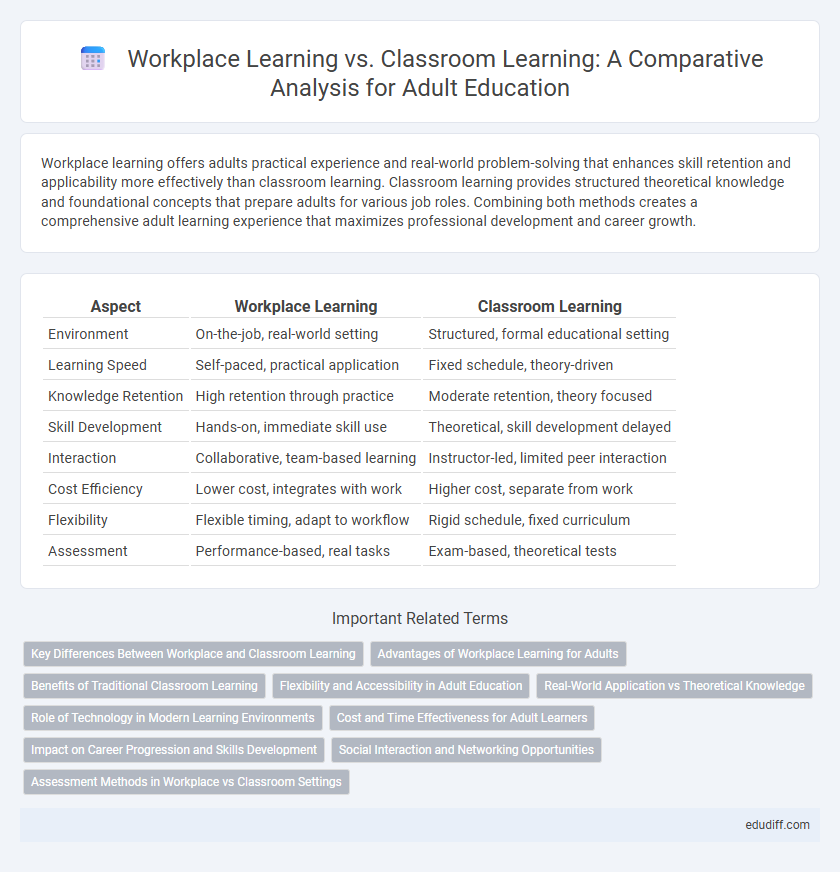Workplace learning offers adults practical experience and real-world problem-solving that enhances skill retention and applicability more effectively than classroom learning. Classroom learning provides structured theoretical knowledge and foundational concepts that prepare adults for various job roles. Combining both methods creates a comprehensive adult learning experience that maximizes professional development and career growth.
Table of Comparison
| Aspect | Workplace Learning | Classroom Learning |
|---|---|---|
| Environment | On-the-job, real-world setting | Structured, formal educational setting |
| Learning Speed | Self-paced, practical application | Fixed schedule, theory-driven |
| Knowledge Retention | High retention through practice | Moderate retention, theory focused |
| Skill Development | Hands-on, immediate skill use | Theoretical, skill development delayed |
| Interaction | Collaborative, team-based learning | Instructor-led, limited peer interaction |
| Cost Efficiency | Lower cost, integrates with work | Higher cost, separate from work |
| Flexibility | Flexible timing, adapt to workflow | Rigid schedule, fixed curriculum |
| Assessment | Performance-based, real tasks | Exam-based, theoretical tests |
Key Differences Between Workplace and Classroom Learning
Workplace learning emphasizes practical, on-the-job experience, allowing employees to apply skills in real-time situations, while classroom learning centers on theoretical knowledge delivery in structured environments. The immediacy of feedback and problem-solving in workplace learning contrasts with the scheduled assessments and predefined curriculum typical of classroom settings. Adult learners in workplaces benefit from personalized, context-driven training that enhances job performance, unlike the generalized content often found in traditional classrooms.
Advantages of Workplace Learning for Adults
Workplace learning offers adults practical, hands-on experience directly aligned with their job roles, enhancing skill acquisition and immediate application. This learning method fosters real-time problem-solving and adaptability within authentic work environments, thereby boosting employee productivity and engagement. Furthermore, workplace learning facilitates personalized development through mentorship and feedback, supporting continuous professional growth and career advancement.
Benefits of Traditional Classroom Learning
Traditional classroom learning fosters direct social interaction and immediate feedback, enhancing communication skills and collaborative learning. Structured environments in classrooms support disciplined study habits and personalized guidance from instructors, which improve comprehension and retention. The physical presence in a classroom setting also reduces distractions, promoting a focused and immersive educational experience for adults.
Flexibility and Accessibility in Adult Education
Workplace learning offers adults greater flexibility, allowing them to acquire skills in real-time contexts without disrupting their professional responsibilities. This approach enhances accessibility by integrating education directly into the work environment, overcoming geographical and scheduling constraints common in traditional classroom settings. Adult learners benefit from customizable pacing and immediate application of knowledge, fostering a more effective and practical learning experience.
Real-World Application vs Theoretical Knowledge
Workplace learning offers immersive real-world application, enabling adults to develop practical skills tailored to specific job tasks and immediate problem-solving. Classroom learning emphasizes theoretical knowledge, providing foundational concepts and frameworks essential for understanding underlying principles. Combining both approaches enhances competency by bridging abstract theory with hands-on experience in professional environments.
Role of Technology in Modern Learning Environments
Technology has revolutionized workplace learning by enabling real-time, personalized training through digital platforms, virtual simulations, and mobile applications, enhancing skill development beyond traditional classroom settings. Learning Management Systems (LMS) and Artificial Intelligence (AI)-driven analytics facilitate adaptive learning paths, ensuring employees acquire relevant competencies efficiently while minimizing downtime. This integration of technology supports continuous, flexible education tailored to dynamic job requirements, significantly improving learner engagement and knowledge retention compared to conventional classroom instruction.
Cost and Time Effectiveness for Adult Learners
Workplace learning offers adult learners practical, on-the-job training that significantly reduces both time and financial investment compared to traditional classroom learning. This method minimizes downtime by integrating skill development directly into daily tasks, eliminating commute and material costs typically associated with in-person courses. Employers benefit from faster employee productivity improvements and lower training expenses, making workplace learning a highly cost-effective option for adult education.
Impact on Career Progression and Skills Development
Workplace learning accelerates career progression by providing hands-on experience and real-time problem-solving skills that directly align with job responsibilities. Classroom learning offers foundational knowledge and theoretical frameworks essential for understanding complex concepts and regulatory standards in various industries. Combining both methods enhances skill development, ensuring adaptability and continuous professional growth in dynamic work environments.
Social Interaction and Networking Opportunities
Workplace learning fosters real-time social interaction and networking, allowing adults to build professional relationships and collaborate with diverse colleagues. Classroom learning offers structured environments where peers engage in discussions and group activities, enhancing social skills within a controlled setting. Both methods contribute uniquely to developing interpersonal connections vital for career growth and knowledge exchange.
Assessment Methods in Workplace vs Classroom Settings
Assessment methods in workplace learning emphasize real-time performance evaluations and practical skill demonstrations, leveraging direct observation and project outcomes. Classroom learning relies heavily on standardized tests, quizzes, and written assignments to measure knowledge acquisition and theoretical understanding. Workplace assessments prioritize adaptive feedback and situational problem-solving over traditional graded exams common in academic settings.
Workplace Learning vs Classroom Learning Infographic

 edudiff.com
edudiff.com